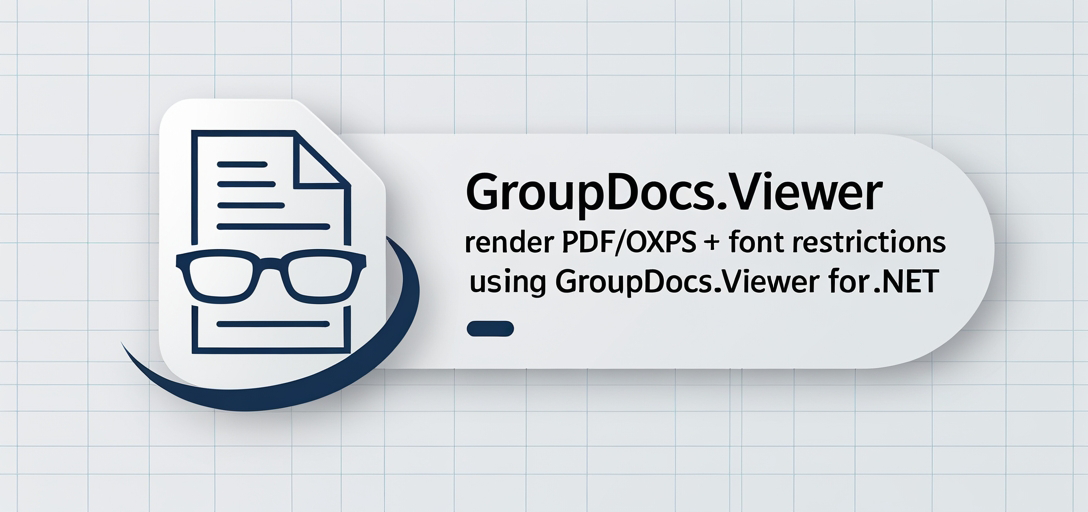Render PDF/OXPS with Font Restrictions Using GroupDocs.Viewer .NET: A Comprehensive Guide
Introduction
Rendering XPS or OXPS documents can be challenging due to font license restrictions. This tutorial will guide you through rendering these documents effectively using GroupDocs.Viewer for .NET. Ideal for document management systems, content publishing platforms, and applications requiring seamless document conversion, this solution is invaluable.

In this guide, you’ll learn how to:
- Set up GroupDocs.Viewer for .NET
- Render XPS/OXPS documents with embedded fonts
- Disable font license restrictions during rendering
Prerequisites
Ensure the following before starting:
Required Libraries and Versions
- GroupDocs.Viewer for .NET: Version 25.3.0 or later.
- Development Environment: Visual Studio (2017 or newer) or any compatible IDE supporting .NET development.
Environment Setup Requirements
- A C# project in your chosen IDE.
- Access to NuGet Package Manager for library installation.
Knowledge Prerequisites
- Basic understanding of C# and .NET framework concepts.
- Familiarity with handling file paths and directories in a .NET environment.
With the prerequisites covered, let’s set up GroupDocs.Viewer for .NET.
Setting Up GroupDocs.Viewer for .NET
Installation Information
Install GroupDocs.Viewer using either the NuGet Package Manager Console or the .NET CLI:
NuGet Package Manager Console
Install-Package GroupDocs.Viewer -Version 25.3.0
.NET CLI
dotnet add package GroupDocs.Viewer --version 25.3.0
License Acquisition Steps
- Free Trial: Start with a free trial to explore features.
- Temporary License: Obtain a temporary license for extended evaluation.
- Purchase: Consider purchasing for full access and support.
Basic Initialization and Setup
After installation, initialize GroupDocs.Viewer in your C# project:
using System;
using GroupDocs.Viewer;
namespace DocumentRendering
{
class Program
{
static void Main(string[] args)
{
// Initialize the Viewer object with the path to your document
using (Viewer viewer = new Viewer("path/to/your/document.oxps"))
{
Console.WriteLine("GroupDocs.Viewer is set up and ready!");
}
}
}
}
With GroupDocs.Viewer configured, let’s implement rendering OXPS documents with font license restrictions disabled.
Implementation Guide
Rendering XPS/OXPS Documents with Font License Restrictions Disabled
Overview
This feature allows you to render XPS or OXPS documents while bypassing embedded font license verifications. It is useful when dealing with proprietary fonts that have licensing constraints.
Step-by-Step Implementation
Define Output Directory and Page File Path Format Set up your output directory:
string outputDirectory = "YOUR_OUTPUT_DIRECTORY"; // Use your desired output directory path
string pageFilePathFormat = System.IO.Path.Combine(outputDirectory, "page_{0}.png");
This snippet specifies where rendered pages will be saved.
Create a Viewer Instance
Initialize the Viewer object for an OXPS document:
using (Viewer viewer = new Viewer("YOUR_DOCUMENT_DIRECTORY/TestFiles.OXPS_EMBEDDED_FONT")) // Replace with your actual document path
{
// Further configuration and rendering steps will go here.
}
This step prepares the document for rendering.
Set Up HTML View Options
Configure HtmlViewOptions to render with embedded resources:
HtmlViewOptions options = HtmlViewOptions.ForEmbeddedResources(pageFilePathFormat);
This option ensures that all necessary resources are embedded within each page file, facilitating offline access.
Disable Font License Verifications Disable font license verifications by setting this property:
options.PdfOptions.DisableFontLicenseVerifications = true;
By disabling this verification, you can render documents without being hindered by font licensing issues.
Render the Document
Finally, use the View method to render your document with the specified options:
viewer.View(options);
This command executes the rendering process based on your configurations.
Troubleshooting Tips
- Missing Fonts: Ensure all required fonts are installed or embedded within the document.
- File Path Issues: Double-check directory paths and file names for typos.
- License Errors: Verify that you have a valid license if encountering licensing issues.
Practical Applications
Real-World Use Cases
- Content Publishing Platforms: Render documents with proprietary fonts without legal constraints.
- Document Management Systems: Ensure seamless document viewing across different platforms.
- Legal and Financial Industries: Handle sensitive documents requiring specific font usage.
- Academic Institutions: Share research papers with embedded diagrams and text.
- Marketing Agencies: Create visually consistent presentations and reports.
Integration Possibilities
- Integrate with .NET web applications for dynamic document viewing.
- Use within desktop applications to provide offline access to rendered documents.
- Combine with cloud storage solutions like Azure Blob Storage or AWS S3 for scalable document management.
Performance Considerations
Optimizing Performance
- Memory Management: Efficiently manage memory by disposing of
Viewerobjects after use. - Resource Usage: Monitor resource usage, especially when rendering large batches of documents.
- Batch Processing: Implement batch processing to handle multiple documents efficiently.
Best Practices for .NET Memory Management with GroupDocs.Viewer
- Always wrap
Viewerinstances in ausingstatement to ensure proper disposal. - Profile your application to identify and address memory leaks or high resource consumption areas.
Conclusion
In this tutorial, we explored how to render XPS/OXPS documents while disabling font license restrictions using GroupDocs.Viewer for .NET. By following the steps outlined, you can effectively manage document rendering in various applications.
As next steps, consider exploring additional GroupDocs.Viewer features and integrating them into your projects. Experiment with different document types and configurations to fully leverage this powerful library.
FAQ Section
What is GroupDocs.Viewer for .NET?
- It’s a versatile library that allows developers to render various document formats within their applications without needing native software installations.
How can I handle font licensing issues with GroupDocs.Viewer?
- By using the
DisableFontLicenseVerificationsproperty, you can bypass font license restrictions during rendering.
- By using the
Can I use GroupDocs.Viewer in a cloud environment?
- Yes, it’s designed to work seamlessly within cloud applications and services.
What are some common challenges when integrating GroupDocs.Viewer?
- Challenges may include managing dependencies, configuring output paths, and handling large document volumes efficiently.
Is there support for non-standard fonts in GroupDocs.Viewer?
- While it can handle embedded fonts, ensure that all necessary fonts are available or embedded within your documents to avoid rendering issues.